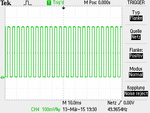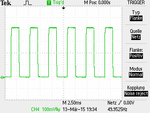T
treez
Guest
Hello,
We have a 150W LED driver. The LED bank is 150V and with 1A in it.
Supposing we suddenly turn off the LED current (with a series transistor) for just 1ms (and then bring it straight back on) so that we can take an ambient light reading, -do you think that anyone would notice a flicker?
This 1ms turn-off would be done once every minute.
We have a 150W LED driver. The LED bank is 150V and with 1A in it.
Supposing we suddenly turn off the LED current (with a series transistor) for just 1ms (and then bring it straight back on) so that we can take an ambient light reading, -do you think that anyone would notice a flicker?
This 1ms turn-off would be done once every minute.

